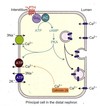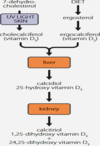BCS Flashcards
(95 cards)
What are the functions of calcium? (7)
Bone growth and remodelling Secretion - flux of intracellular calcium tells glands to release hormones Muscle contraction Blood clotting - calcium citrate used to help blood clot Co-enzyme Stabilization of membrane potentials - in heart and brain Second messenger/stimulus response coupling
Where is calcium stored?
Mostly in the bone (99%) The rest is extracellular
What regulates ionised ca2+
PTH and vitamin D
What are the functions of phosphate? (4)
Element in: High energy compounds e.g. ATP, Second messengers e.g. cAMP Constituent of: DNA/RNA, phospholipid membranes. bone Intracellular anion Phosphorylation (activation) of enzymes
Where is phosphate stored?
Skeleton 90% 9.97% intracellular (of which 50% is free, 50% is bound)
How is free phosphate regulated?
Controlled by kidneys, PTH, FGF23
What regulates the amount of calcium and phosphate in the blood?
The kidney Calcium - Distal CT Phosphate - Proximal CT
Order of bone remodelling process (4). How long does the process take?
30 days Osteoclasts carving REABOSORPTION well Osteoblasts form osteod, to REVERSE the changes Osteoblasts initiate FORMATION of new bone Resting state
What is an osteoclast?
Modified macrophage (from hematopoietic stem cellor mesenchymal stem cell)
Review development of osteoclasts and osteoblasts
PICTURE

Outline the hormonal control of bone remodelling
PTH activates osteoblasts, which controls bone reabsorption but releasing collagen and proteases IGF 1 is main actor
How does the osteoblast stimulate differentiation of osteoclasts? What receptor is activated? What can inhibit differentiation?
Production of RANK ligand The osteoclast recursor has a RANK receptor that is activates via activation of nuclear kappa beta OPG binding inhibits differentiation
Outline the role of osteoprotogenerin - what stimulates it?
also known as osteoclastogenesis inhibitory factor (OCIF) or tumour necrosis factor receptor superfamily member 11B (TNFRSF11B) False receptor to prevent activation of RANK receptor on osteoclast (to ultimately prevent bone reabsroption) Estrogen increases OPG expression (so dip in estrogen during menopause causes bone reabsoprtion)
Describe the activities of bone as an endocrine organ
FGF23 acts in conjunction with PTH decrease phosphate reabsorption by down-regulating NaPi2a and NaPi2c expression in the brush border of the proximal tubule resulting in hyper-phosphaturia and hypophosphatemia regulation high phospate and high 1,25 di hydroxy vit D The primary mechanisms by which adiponectin enhance insulin sensitivity appears to be through increased fatty acid oxidation and inhibition of hepatic glucose production

Outline the role of glucocorticoids, estrogen, calcitonin, thyroxine, vitamin A, androgens and GH on bone turnover

Provide overview of parathyroid gland
4 glands on upper and lower poles of each lobe of the thyroid gland Supernumerary glands not uncommon (source of PTH excess?) 30-50 mg weight Chief cells and oxyphill cells Supplied by blood from the inferior thyroid arteries (thyroid surgery)
What type of hormone is PTH? How can you measure it?
peptide (very short half life) Have to use sandwich assay to measure
What happens to calcium levels in acidosis?
HIGH
Outline the activity of the calcium sensing receptor? Where is it? What type of receptor? Ultimate results of activity

If your calcium levels are two high, what should be happening to your PTH?
There shouldn’t be any in your system
How does vitamin D regulate PTH production?
Calcitriol (1,25 OH2D3) inhibts replication and secretion of PTH To INCREASE calcium

What are the direct actions of PTH on bone activity and in kidney (4)
Stimulate osteoblasts to produce M-CSF and RANK ligand increased bone resorption Increase Ca2+ reabsorption in the distal convoluted tubule Increase phosphate excretion Increases 1-α hydroxylase in the proximal tubule
REVIEW activity of PTH on kidney in more detail

What is the active form of Vitamin D? How is it made?
D3 Cholesterol and UV light on skin / DIET












